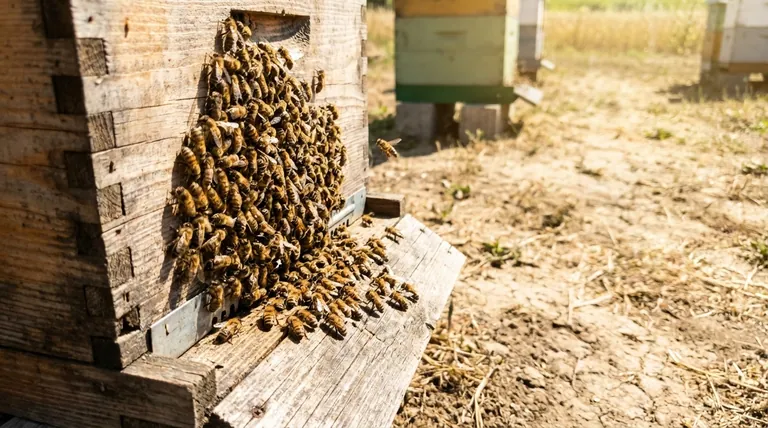In short, an overheated hive leads to colony-wide heat stress. This critical condition forces a cascade of negative consequences, beginning with a halt in productivity and escalating to increased disease susceptibility, which can threaten the entire colony's survival.
The core problem with an overheated hive is not the heat itself, but the massive diversion of energy and labor it causes. The colony is forced to abandon essential tasks like foraging and raising young, shifting its entire focus to emergency climate control.

The Immediate Impact: A Shift in Priorities
When temperatures inside the hive climb to dangerous levels, the colony's collective behavior changes instantly. Normal operations cease as the bees enter a state of emergency management.
The Onset of Heat Stress
Heat stress occurs when bees can no longer easily maintain the stable internal hive temperature required for their survival and brood development, which is typically between 90-95°F (32-35°C). This stress triggers a series of defensive, energy-intensive behaviors.
Diversion of the Workforce
A stressed colony immediately reallocates its workforce. Forager bees, who would normally be collecting nectar and pollen, are recalled to the hive to assist in cooling. Their primary job shifts from resource collection to hive ventilation.
Halt in Productivity
With the field force focused on fanning at the entrance and spreading water to create evaporative cooling, the collection of resources grinds to a halt. This directly translates to reduced production of honey, beeswax, and other essential stores.
The Cascade of Long-Term Consequences
If high temperatures persist, the initial emergency response begins to cause deeper, more lasting damage to the colony's health and future viability.
Compromised Brood Development
The developing brood (eggs, larvae, and pupae) is extremely sensitive to temperature fluctuations. Excessive heat can kill the young or cause developmental defects, weakening the next generation of bees and shrinking the colony's future workforce.
Weakened Immune Systems
Just as with other animals, prolonged stress weakens a bee's immune system. This makes the entire colony more vulnerable to pathogens, pests, and parasites like Varroa mites, turning a manageable issue into a potentially fatal infestation or disease outbreak.
Increased Risk of Absconding
In extreme cases, if the colony determines the location is no longer tenable and they cannot control the temperature, they may choose to abscond. This means they will abandon the hive, leaving behind their brood and food stores in a last-ditch effort to survive.
Understanding the Inefficiencies
The bees' cooling methods are effective but come at a significant cost. Understanding these trade-offs reveals the true strain that overheating places on a colony.
The Energetic Cost of Cooling
Fanning wings and transporting water for evaporative cooling are physically demanding tasks that consume immense amounts of energy. This energy is fueled by the very honey stores the bees are no longer able to replenish, creating a rapidly depleting resource cycle.
The Strain on Water Resources
Evaporative cooling requires a constant and significant supply of water. Worker bees must dedicate their foraging efforts to finding water sources instead of nectar, further contributing to the decline in food production.
How to Apply This to Your Beekeeping
Preventing overheating is not just about comfort; it is a cornerstone of proactive hive management that pays dividends in colony health and productivity.
- If your primary focus is colony health and survival: Prioritize good ventilation and shade to prevent heat stress, which is the root cause of weakened immune responses and brood loss.
- If your primary focus is maximizing honey production: Recognize that every hour your bees spend on emergency cooling is an hour they are not foraging, directly reducing your potential honey yield.
Ultimately, maintaining a stable hive environment is one of the most impactful actions you can take to ensure your bees are resilient, healthy, and productive.
Summary Table:
| Consequence | Impact on the Colony |
|---|---|
| Workforce Diversion | Foragers recalled to fan hive, halting resource collection. |
| Halt in Productivity | Honey, beeswax, and pollen production drastically reduced. |
| Compromised Brood | High temperatures kill or deform developing bees. |
| Weakened Immunity | Stressed bees become more vulnerable to disease and mites. |
| Risk of Absconding | Colony may abandon the hive entirely to survive. |
Protect your investment and maximize your apiary's productivity. An overheated hive is a direct threat to your bottom line. HONESTBEE supplies durable, high-performance beekeeping supplies and equipment designed for commercial apiaries and distributors. From superior ventilation systems to protective shading solutions, our wholesale-focused operations provide the tools you need to maintain optimal hive conditions, ensure colony health, and secure your honey yield. Contact HONESTBEE today for a consultation on our wholesale equipment solutions.
Visual Guide

Related Products
- Professional Galvanized Hive Strap with Secure Locking Buckle for Beekeeping
- Professional Engraved Round Hive Number Tags for Beekeeping
- Langstroth Screen Bottom Board for Beekeeping Wholesale
- Heavy-Duty Galvanized Steel W-Style Pallet Clip
- Multi-Functional Sliding Hive Entrance for Beekeeping
People Also Ask
- What are the two styles of hive straps? Choose the Right Strap for Your Hive Security
- Can straps with hook ends be used for beehives? A Guide to Secure Hive Management
- What are hive straps and why are they used? Secure Your Hives Against Wind, Predators, and Transport
- What is the advantage of using cam buckle straps? Secure Your Load Fast with Simple, Safe Tensioning
- What is the best length for straps used around beehives? Why 12 Feet is the Industry Standard



















